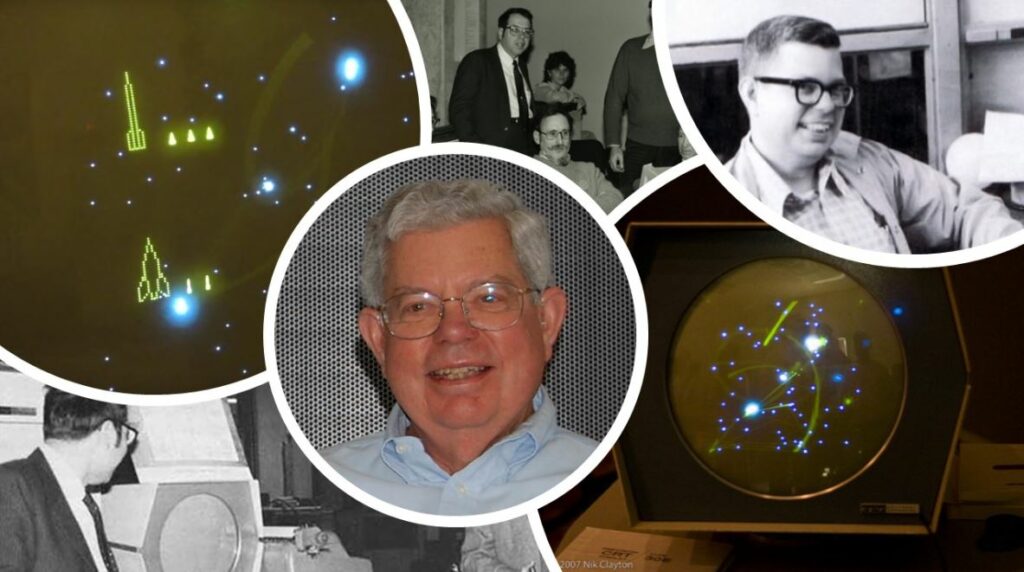
Author: Massimiliano Brolli
Original Publication Date: 19/03/2021
Translator: Tara Lie
In this exciting story, we will catapult ourselves back to 1958 to MIT’s Tech Model Railroad Club and meet Steve Russel, Steve was one of the first hackers and wrote one of the first video games in history, and the very first with a connected Gamepad.
The TMRC was an exclusive club, as we have already seen, which was frequented by brilliant and interesting characters.
They often fit into the classic “geeky” stereotype – bespectacled individuals, not particularly athletic or tall, and more likely to have a ruler in their pockets than a note from a secret admirer.
Finding ourselves towards the end of the 1950’s, calculators that could fit into pockets did not exist, and neither calculators nor grand computers existed outside the domain of large enterprises or the academic world.
Returning to our “main character”, Steve Russel was a small guy who, having newly joined the TMRC, spoke very little. Despite being a rookie, he had already earned a certain fame for himself, thanks to having collaborated with professor John McCarthy. Professor McCarthy was one of the pioneers in the field of artificial intelligence, and Russell worked with him on the implementation of a programming language called “LISP”.
In the summer of 1961, Digital Equipment donated a PDP-1 to MIT, a new computer. Compared to the old IBM 704, “The Hulking Giant” and the large TX-O, the PDP was much smaller, barely the size of a family car!
Russell worked on his projects tirelessly, and was given the nickname “Slug”, however despite the name he was an alert and energetic person. He loved science fiction novels and was a big fan of Doc Savage (a character not dissimilar to Flash Gordon), and of course was a fan of model trains.
Stemming from his passion for science fiction books, Steve Russell had a striking idea – to write an interactive video game set in outer space. Unsurprisingly, his proposal generated more than a little excitement among the other members of the TMRC.
As time went on however, the other members grew impatient and continuously asked Russell when the game would be finished. In fact, his peers began to complain that the project was a waste of time, and even Russell became increasingly frustrated and demotivated with it.
It was Alan Kotok, one of the older TMRC members, who took it upon himself to push Russell to finish the work he had been so excited to start. Kotok’s contribution proved to be valuable, particular in the case of the sine-cosine routine. Russell had told him that he needed a sine-cosine routine, but did not have the ability to write on himself. Hearing this, Kotok went directly to Digital Equipment, the creators of the PDP, and asked if they could provide one.
It took Steve Russell 6 months and 200 hours of work to complete the first version of the game, a simple duel between two spaceships. The players could control the ships by interacting with switches built for the PDP. This allowed them to control both the speed and direction of the ships, which could also fire torpedoes. Russell called the game “Spacewar!”.
In typical TMRC style, the other constituents improved and modified ‘Spacewar!”.
Some of these changes improved the game to such an extent that they became essential elements to the game itself. Once ‘Spacewar!’ was completed, it had an accurate star-map background, and a sun with its own gravitational field on the “front” part – where the combat between the spacecraft took place). Forgetting today’s PS5 standards, ‘Spacewar!’ was comparatively advanced and impressive in terms of the technology at the time.
The best players knew how to accelerate near the Sun’s gravitational field, turning around it, and beat the less experienced players with their guard down. Moving too close to the Sun, of course, would result in a player’s untimely demise.
Another interesting addition to the game was the jump to hyperspace. When a player was trapped, they could press a particular button and disappear, re-appearing at a random point on the screen. In doing so however, they also risked appearing close to the Sun and losing the game.
To add to the realism, Russell originally created different trajectories for his random missiles – some would fly straight, others veered. However, based on the reactions and response of the other players to the curved trajectories, in the end he opted for simply implementing only the straight line trajectories.
Aside from these changes, Russell’s initial vision for ‘Spacewar!’ remained intact.
The TMRC, however, was not content to just introduce other improvements. Instead, they invented another fundamental part of the gaming world…
Alan Kotok and Bob Sanders were looking for a solution to sore elbows, caused by the switches that had to be pressed to control the game. Thus, they put together controllers that could be connected to the computer instead.
These controllers were much easier to use than the PDP controls, and had dedicated buttons for each function of the game, from launching the missiles to jumping to hyperspace.
These Hackers had invented the first gamepad.
Although the first videogame, ‘OXO, ‘ was made in 1952, and the second in 1958 called ‘Tennis For Two’, ‘Spacewar!’ was the very first to be equipped with a controller.
This feat went largely unrecognised at the time, as PDPs were not computers used by ordinary people, hence the game was not of much interest to anyone else. In fact, Steve Russell did not earn even a single dollar from the sale of ‘Spacewar!’ software.
Steve Russell never graduated, instead deciding to work at Stanford University. It was there that he met another computer wizard during the 1970’s, one Bill Gates, who was already very familiar with crashes.
Follow us on Google News to receive daily updates on cybersecurity. Contact us if you would like to report news, insights or content for publication.
